 08 9371 7711
08 9371 7711 Engineering Blog
Engineering Blog
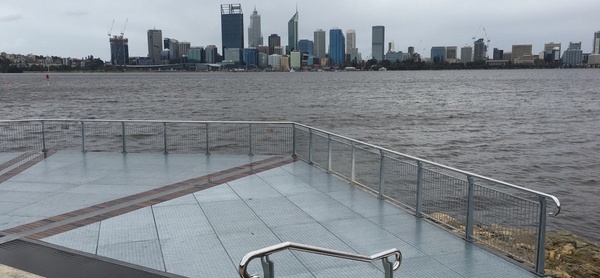
Screwpile Australia is about to manufacture and install screw piling for a new boardwalk in a eco-sensitive environment. As their certifying design engineers Foundation Engineering Pty Ltd (FE) decided it was timely to look at the more than 20 boardwalks and viewing platform projects they've done since 1996. Installed in a wide range of environments it provide a unique window of opportunity to at look at previous corrosion protection regimes for exposed components.
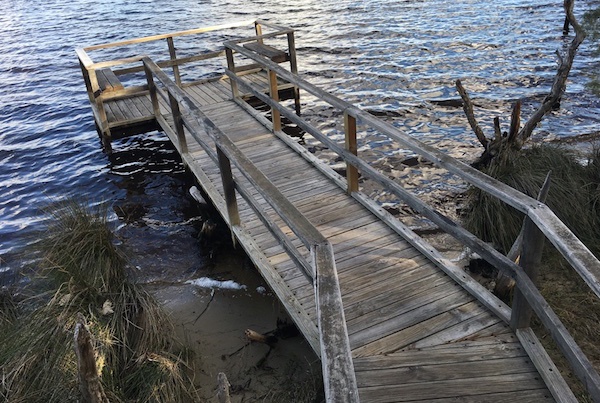
The following “Soft Audit” observations and interpretations are considered relevant for future "screwpiled" boardwalks for design, corrosion protection and ongoing maintenance. Steel corrosion is a topic of some debate particularly when it comes to piling. Regardless of design principles specified in the relevant Codes it seems everybody has differing opinions and experiences. And, we're sure that’s true as nothing plays a more important roll in structure serviceability than the environment it coexists in. We identified relevance to this with just slight environmental changes on the same structures. As we were unable to find any published data that dealt with these types of structures located in a variety of environments throughout Western Australia we believe this information invaluable to the stakeholders of the future.
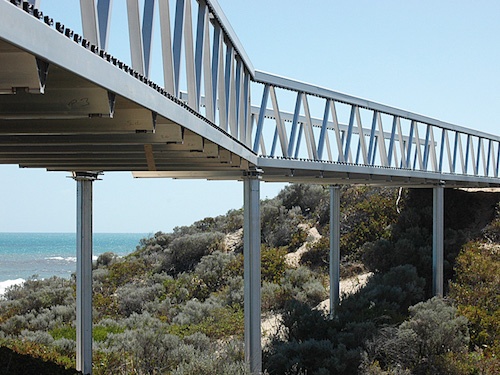
No approval had been given from the various asset owners for us to test measure sectional steel corrosion/loss so our inspection was limited to visual and photographic. In conjunction with the original installation information and an understanding of the environmental conditions we gathered sufficient information to draw the reasonable conclusions herein. Our main focus centered on screw pile exposure elements (the piers) and connecting interface as these are the first to show signs of corrosion and stress. Where little to no corrosion was present just below water or ground levels, our assumption is that a similar or better scenario applied to the remainder of the screw pile below.
As with any design, corrosion maintenance influences ultimate serviceability. We quickly became concerned that none of the structure piling inspected showed ANY signs of corrosion maintenance. For the purposes of this document we have assumed continuity in that it's not likely to happen on future structure.
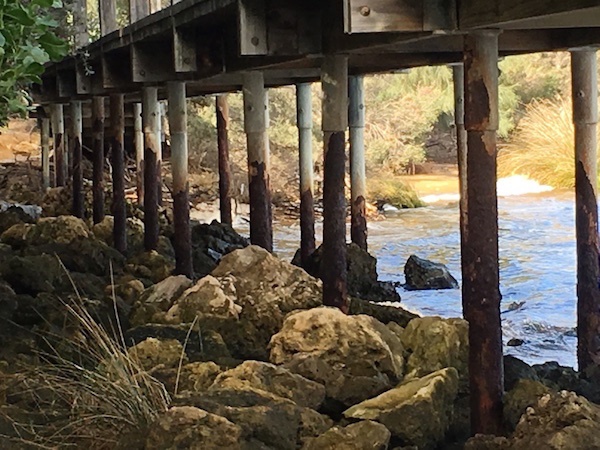
With the recent introduction in WA of unqualified “backyard" screw piling contractors offering cheap non-engineered uncertified design and installation, issues of piling serviceability is more relevent than ever before.
THE SITES

Boardwalks and platforms are installed in varying environments from dry escarpments through to shoreline and offshore fresh and saltwater locations consisting of sands, muds and silts. As expected screw piles installed at saltwater splash-zones suffered the greatest corrosion impact. Not withstanding any site-specific details we summarised all structures into one the following catagories:
(An extract from the Australian Piling Code AS2159-2009, Section 6, is provided at the end of this blog to aid in future classification methods)
Dry Sandy Sites
Images shows installation on a steep gradient site in excess of 35 degrees. This challenging Installation occurred in 2000 along a 200m stretch of the Swan River escarpement in Mosman Park.
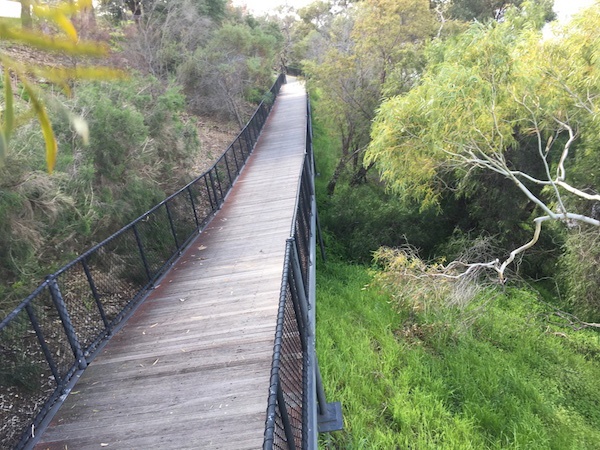
Over 200 galvanised compression and tension screwpiles were installed due to potential soil slip and earthquake design factors. Installing machinery needed to be winched down to each piling location. Screw pile ground anchors were socketed into the limestone rock at varying depths below very loose sands. Large interface plates were site welded to the piles to pick-up varying installation alignment, this was fabricated by others.
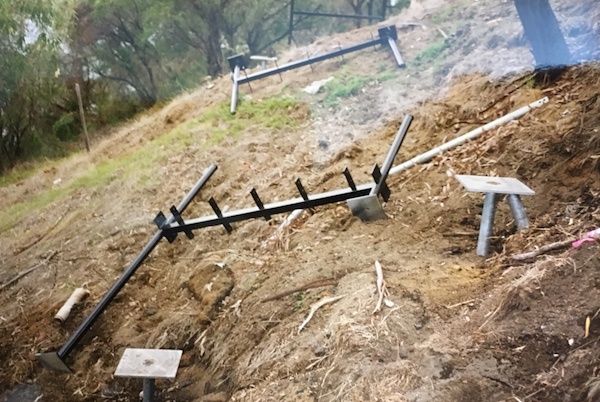
Site Summary: The boardwalks is not influenced by saltwater spray. Painted boardwalk steel railing is only just now starting to show signs of chemical change. The exposed galvanised piles pier elements show no sign of degrade. Screwpiles were sandblasted and double hot dipped to increase galvanising thickness from 80mic to 120mic.

Only the underside weld of connecting interface plate will require attention in the near future. Galvanising on the screwpiles is performing as intended and a 25-35 year serviceability period is likely to be achievable. Future periodical inspections should be carried out to monitor this.
Fresh Water Sites
Numerous installations occurred throughout 1999, 2000, 2004, 2007, 2010. All screw piles were hot dipped galvanised and include exposed pier elements. These sites are grouped into two sub-catagories, those believed to be purely sweet-water and those that appeared to be influenced by tidal or ground water salinity due to the proximity of salty water, i.e. Swan River downstream. No chemical analysis of the soil/water or seasonal effects was conducted.
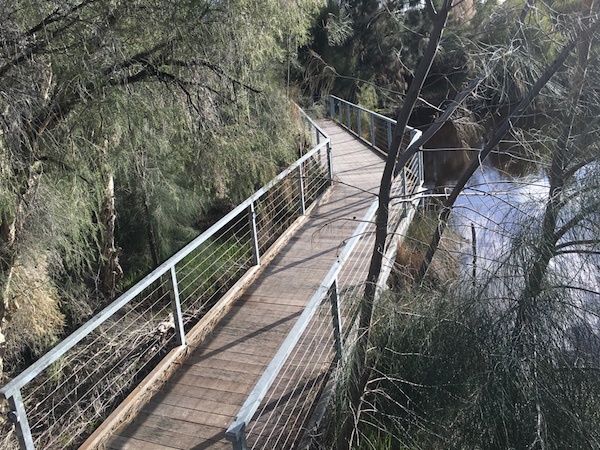
The images above and below show a fresh backwater lake which is approximately 50 meters from the Canning River in Manning. We have assumed the maximum seasonal salinity of this part of the river is up to 50% of oceanic around Perth metro. Actual ground water salinity is likely to be significantly less and subject to seasonal flooding from the river system.
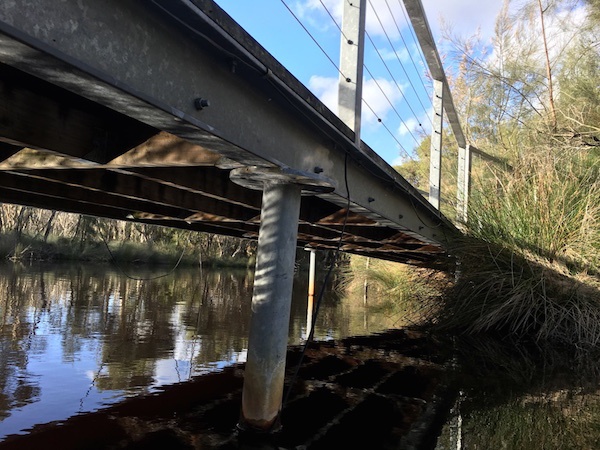
Installed in 2004, this image clearly shows utilisation of the galvanised protection and steel scaling at the current water level and below. Visible seasonal water level staining indicates changes have occurred but the current level appears dominant at this point in time. Corrosion does extend below this water level but it is not known to what level.
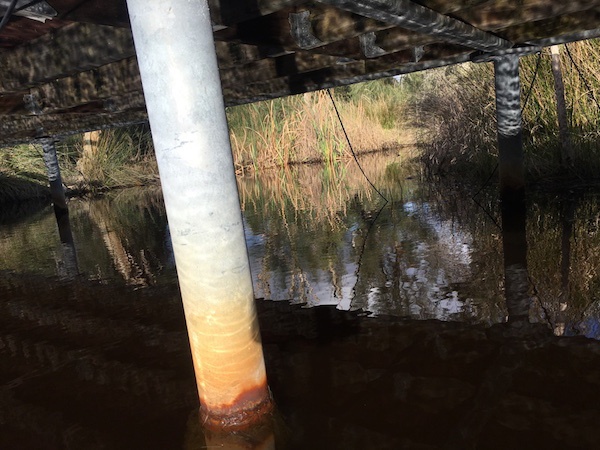
Site Summary: It appears no corrosion maintenance has occurred. Structural integrity has not been compromised. Corrosion maintenance is required to stop further steel scaling. This site is environmentally sensitive, a preferred remedial options is a Denso (petrolatium) tape solution to limit contamination of this sensitive waterway. Upon corrosion protection reinstatement to the effected areas the screwpiles will provide many more years of service life providing any continued waterline maintenance requirements are adhered to. Where no maintenance is to occur design engineers should consider additional protective coating measures for similar projects in the future to ensure design serviceability of 25-35 years is achievable. The extent of the additional protective coating will need to be determined however there is no evidence to suggest a measured benefit exists for any protection in excess of 1.5m below the lowest surface level of oxygen exposure on the pier element.
The Old Coal Dam Lake used to be part of the old Midland Railways and Workshops site. This installation post dates the previous site by some 3 years (2007). Site consists of numerous large boardwalks and viewing platforms both on land and in water.

Visual inspection above the current waterline shows only minor water staining and no corrosion evident to the screw pile pier elements or interface.
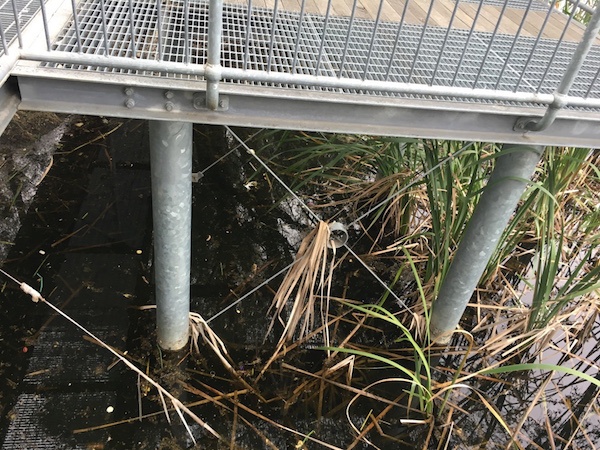
To our knowledge there are no salinity issues here, only a history of industrial contamination many years ago. Screwpile Australia's management recalls the distinct smell of coal tar at the time of installation. The environment now however appears and smell's prestine.
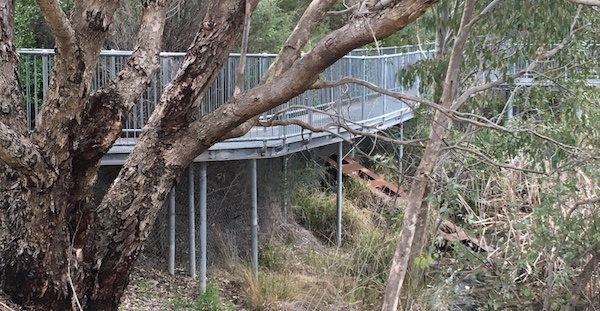
Site Summary: No corrosion is evident and at nine years since installation galvanising on the water based piling appears to be performing equally to that of land based and serviceabilty expectation (25-35 years) at this stage seems to be inline with original design expectations, however future scheduled inspection and monitoring needs occur.
Gobba Lake in Bayswater has two installations. A double viewing decks in 2000 and another larger platform in 2010. Gobba lake is purely sweet water and the galvanised platforms piers show no sign of deterioration or corrosion. Currently there are no concerns of ongoing serviceability.

Note the difference water levels between July 2000 and August 2016.
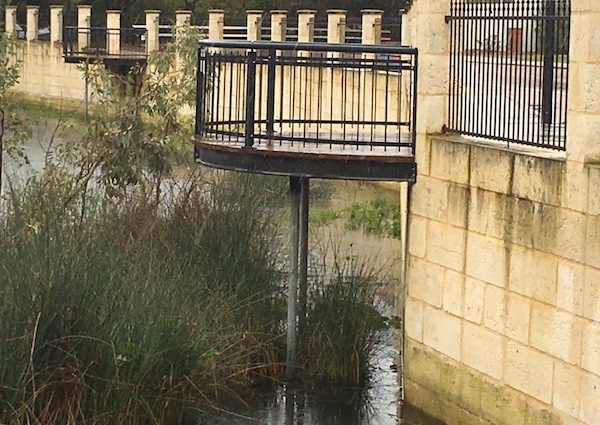
We noted the design of foundations on the larger deck are unnecessarily complicated and were expensive. Screwpile Australia had conducted EFCPT's onsite to determine the soil profile and bearing capacity at the shoreline. Screwpile proposed a monolithic galvanised screwpile/pier interfaced directly to the structural deck beams, but the project was considered to far advanced and the original design remained.
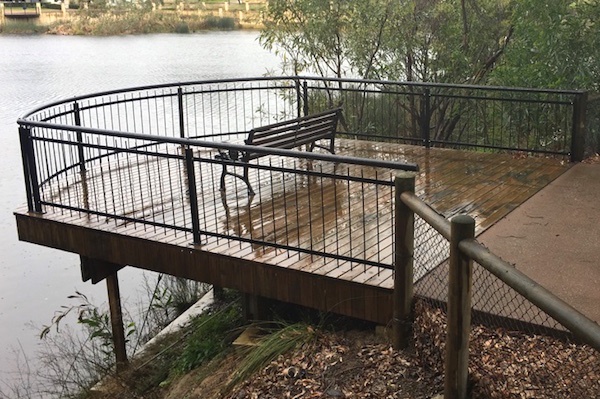
Site Summary: Subject to a more detailed assessment below the existing water level encountered during inspection corrosion protection appears to be performing in accordance with serviceability requirements at the original 2000 installation and providing periodical inspection occurs will remain so for another 5 to 10 years without any significant maintenance to the existing screwpile piers. No assessment of the piles below ground was conducted for either staged piling.
Cygnia Cove Wetlands are a series of fresh water swamp lakes. This large boardwalk & platform was constructed as part of the new residential sub-division. In 2009 galvanised steel screw piles were installed above and below the natural water table.
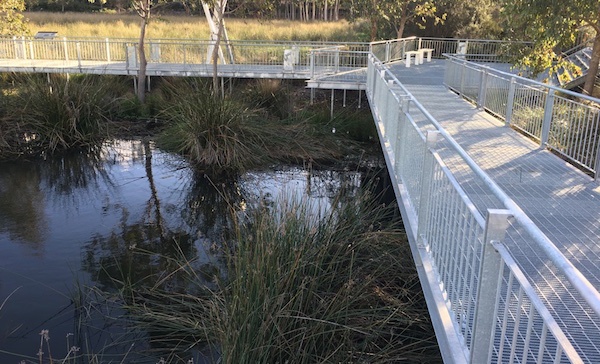
Screwpile pier elements were kept to a minimum by the developers boardwalks design engineer which, in our view, was a mistake as the interface between the screwpile & actual boardwalk piers leaves a lot to be desired.
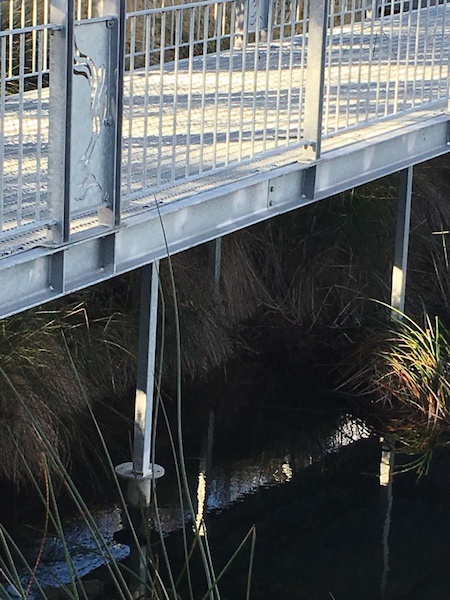
Site Summary: There are no immediate corrosion concerns other than to state this wetland consists of wet mud banks and water level fluctuations at screwpile locations are evident. The site has varying water levels and exposed soft mud banks that are in direct contact with the pier elements. We recommend Denso wrap be applied to the contact areas (+0.5m each way) to limit the effect of the oxygenated soft wet mud currently in contact with the galvanised piers. Without additional protecting being applied soon it’s likely the intended serviceability requirement will not be met and remedial works will be required. We note sites similar to this in proximity of the Perth metro river systems can be in PASS or ASS (acid sulphates) zones, particularly where ground water levels fluctuate dramatically. Future projects in these conditions should specify additional corrosion protection over the galvanising, such as full shaft length polypipe sleeving, fitted at time of screwpile fabrication/manufacture. The additional cost of the polypipe is considered minimal versus potential ongoing maintenance expense.
Overall, other than the issue at Cygnia Cove, corrosion at the remaining sites appears to be inline with expectations, except for one important factor, the lack of ANY maintanence. Some of these site date back to 2000 (16 years) and are still within their serviceability period. Ongoing inspection and the appropriate corrosion preventative maintanance will be key to keeping them so.
Saltwater - Splash & Spray Zones
The most agressive of all corrosion conditions, this section show the most concerning levels of corrosion. A couple of sites are at threat of being structurally compromised soon if not already. The most concerning location is located up stream in the Canning River. A combination of natural and man induced site conditions have resulted in promoting corrosion beyond what would normally be expected at this location. This is a classic example of an unforseen circumstance having a significant impact on the expected serviceability period. All sites that have installation dates exceeding 10 year are in urgent need of corrosion protection maintenance or reinstatement.
Burswood Boat Ramp Loading Jetty galvanised screwpiles were installed in 2002. Large central mono screwpiles were installed under the spanning T-support beams at land and water locations. We were not able to view the screwpiles below the underwater deck.
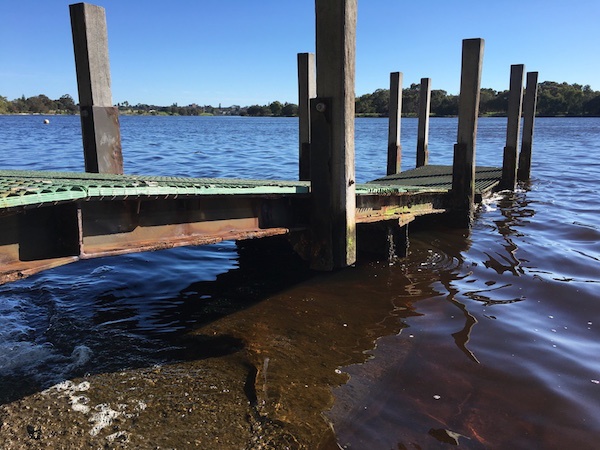
The before and after images below show the screwpile and support beam just after installation in 2002 and the other shows the condition as at time of inspection in 2016. Its clear the galvanising protection on ther screwpile is performing better than the corrosion protection on the structure itself.
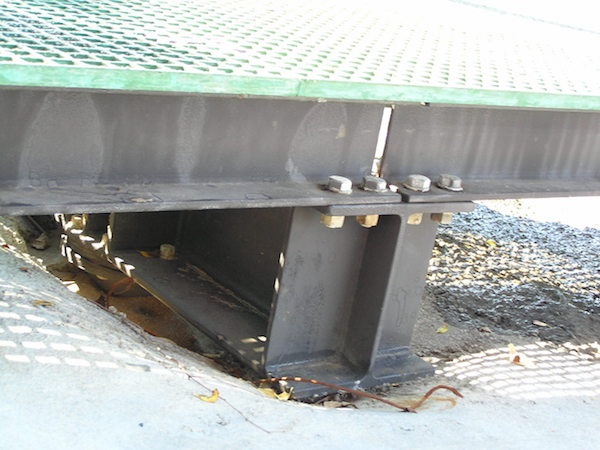
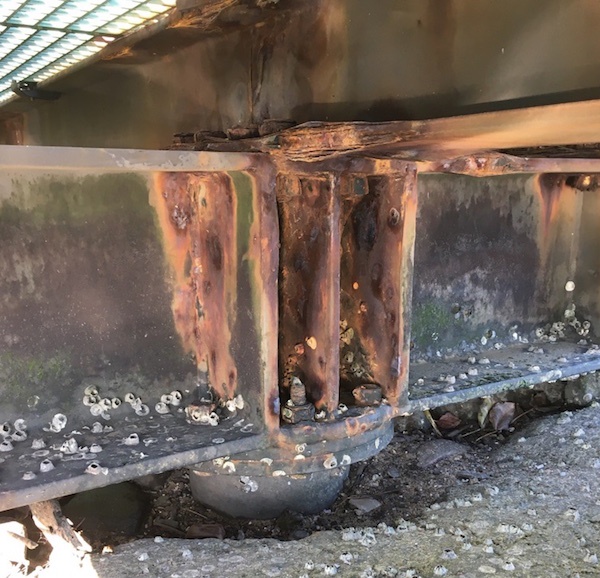
Based on what was visable we do not see any areas of corrosion concern on the screwpiles, however there are corrosion concerns regarding the connecting bolts and degree of corrosion to the structure above.
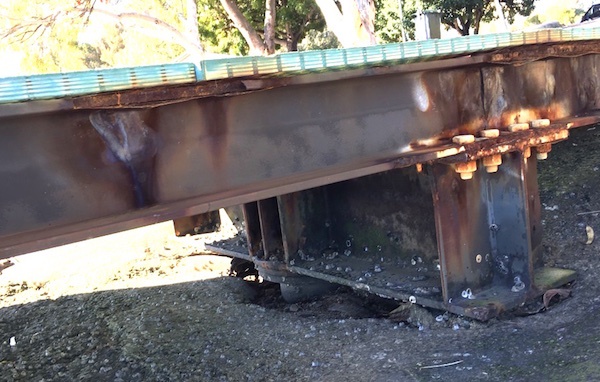
Site Summary: Visual inspection shows no sign of corrosion to exposed interfaces of the screwpiles therefore we assume the same applies for the screw piles below the water surface. No maintenance appears to have occurred as the structure has steel corrosion scaling. Considering the installation period of 14 years we remain surprised at what appears to be a limited amount of galvanising deterioration to the exposed screwpile sections.
Canning RIver had two boardwalks installed back in 2000. One runs along the foreshore and the other passes through a shoreline based paperbark tree and reed marsh. Both structures are suffering from lack of corrosion maintanence and are experiencing severe pier corrosion.

The first images are of the shoreline installation which is exposed to a larger fetch of water influenced by prevailing winds and induced wind/waves/spray actions. The galvanised coating deteriorated some time ago to the point where severe steel corrosion scaling has occurred. The extent of scale is so severe that serviceability is now in question. Unless immedate remedial works are carried out there is a real threat that the asset may be lost entirely.
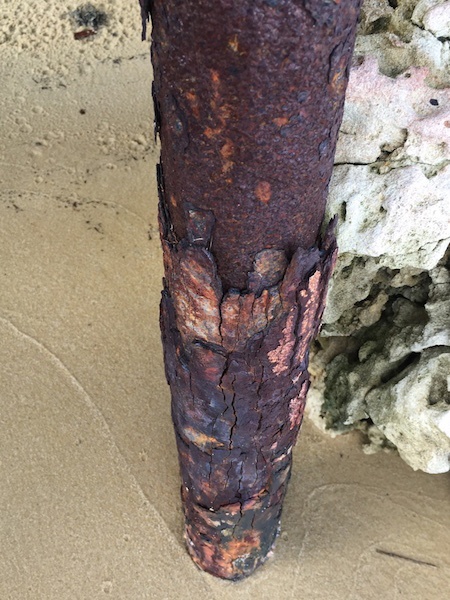
Investigation of the shoreline and armour location shows a distinct profile of corrosion severity where armour induces splash and spray. Had the armour not been there the severity of corrosion is likley to have been less severe.
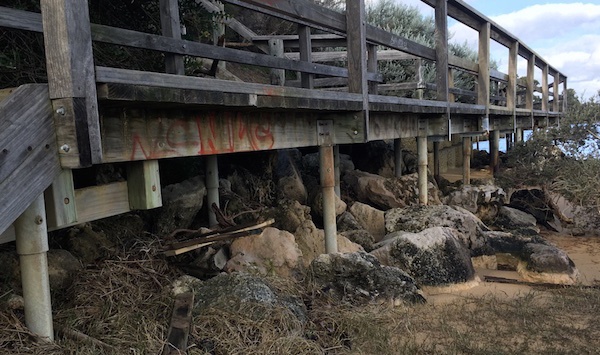
The paperbark marshland boardwalk environment is only 5 kilometers up stream. Corrosion is less severe and the effects of the prevailing wind wave action apprear limited in comparrison to the shoreline site.
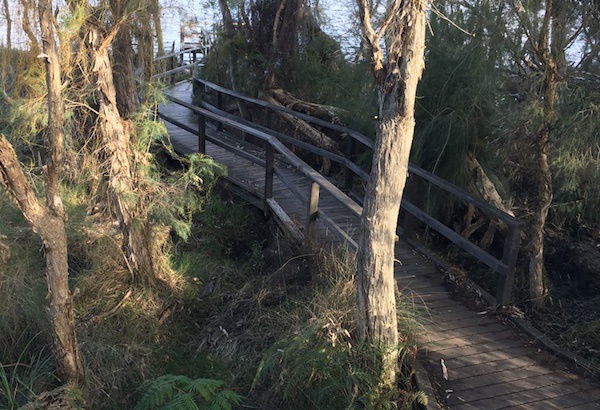
Screwpile pier element are much shorter. There appears to be a corrosion advantage from an increased level of local tannins in the water. The images below show the brown waxy film over the steel and timber which may have offered a degree of additional protection from the elements.
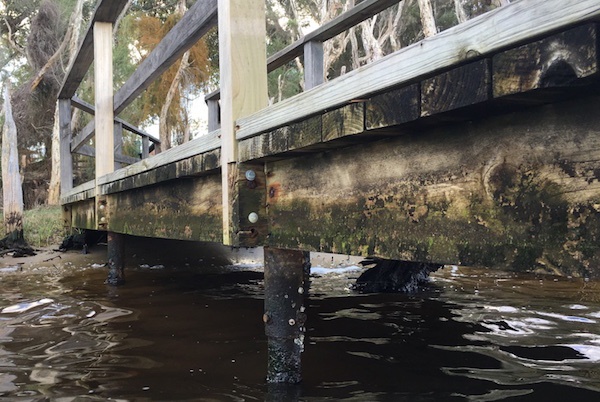
Regardless, corrosion protection has deteriorated to a point where remedial works are now required as steel scaling is occurring. Installation occured 16 years ago, if the screwpiles are left unmaintained servicability will not extend another 16. The internal environment is sensitive and any remedial works are going to be limited and based on impact.
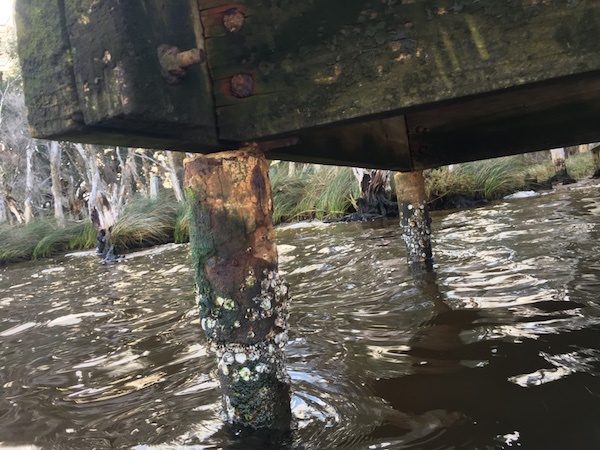
Sites Summary: Over recent years the salinity levels of the Swan and Canning Rivers has increased significantly and is likley to have impacted on the rate of corrosion. Combined with the lack of corrosion maintanence it has significant reduced serviceability timelines. Both sites require immediate remedial corrosion and in some instances structural works. Failure to do so will result in the loss of both assets in the near to short term.
For the shoreline boardwalk two practical remedial options are: 1) Remove the corroded sections of the exposed screwpile piers and install new welded steel sleeve piers, including Denso wrap protection and additional painted corrosion protection to the pier interface brackets. 2) Install new screwpiles to the outside edges and cross support beams that have the appropriate corrosion protection, in this case galvanised and polypipe (or hi-build epoxy) casement/coatings.
For the paperback marsh boardwalk practical remedial works is likely to be limited a cleanup prep and Denso wrap of exposed piers and anti-corrosion painting of the interface brackets etc.
Future boardwalks that require 25-35 year design life periods in these environments will require additional corrosion protection over and above hot dip galvanising, see chart below. Protection options are similar as to what has already been covered previously in line with specific circumstances.
Mandurah estuary Dolphin Cove restaurant boardwalk screwpiles were all installed in 2003. Along with the boardwalk all of the restaurants and cafes' were eventually built on screw piles. The deepest screwpiles installed to 23.5m are at the Dome Cafe' site.
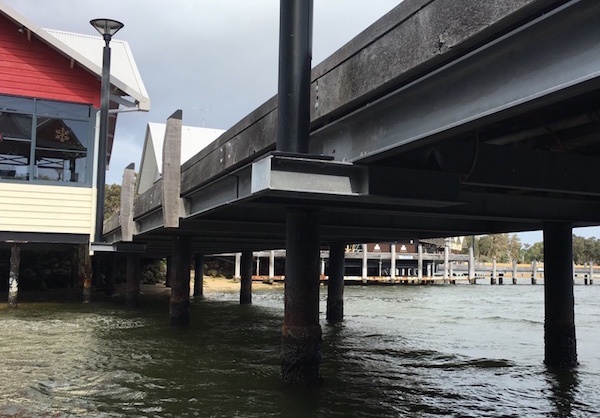
Screwpile were painted with marine hi-build epoxy urethane.
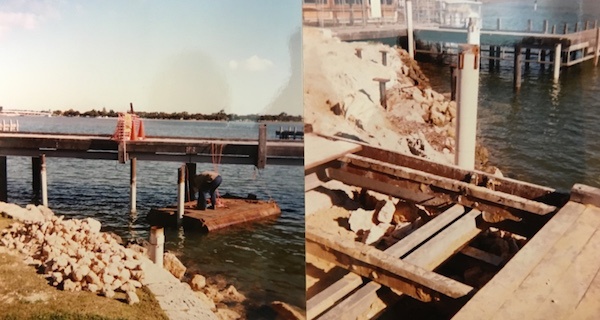
Hi-build epoxy coating is still offering corrosion protection but where pile lengths were site cut to required boardwalk RL’s and the onsite welding of connection plates occurred (by other) there appear to have been insufficient post welding corrosion preperation resulting in coating degradation and steel scale corrosion is occurring.
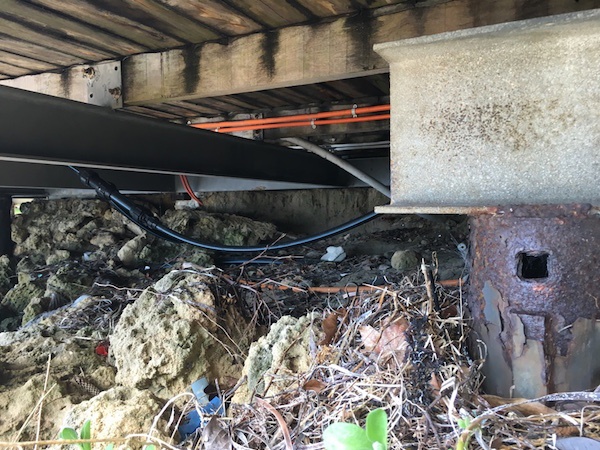
There is no evidence to support any corrosion maintenance has occurred as can be seen of other structural steelwork corrosion in the images. The extent of corrosion will significantly increase in a short period of time affecting the ultimate serviceability period. Again with a little preventive maintenance current corrosion concerns would have been avoided.
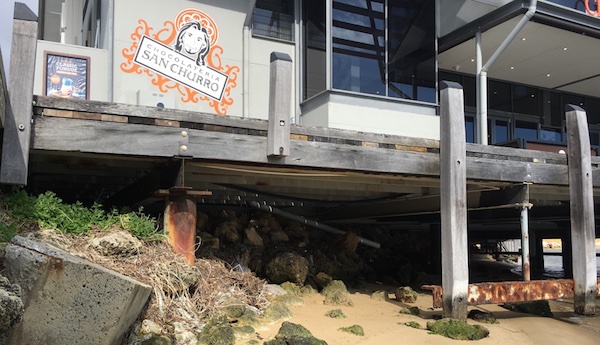
Site Summary: The images shows rust staining on the piles but it's streak from the unprotected and rusting steel above the screw piles. Apart from the original poorly prepped welded areas the original hi-build epoxy coating is performing as would be expected. Corrosion is controlled and when the required coating maintanence occurs at the effected areas serviceability is expected to remain on track.
South Perth Foreshore Viewing Platform galvanised 500kN tension screwpiles were installed under the observation deck in 2010. There are no corrosion concerns expected or evident at this stage.
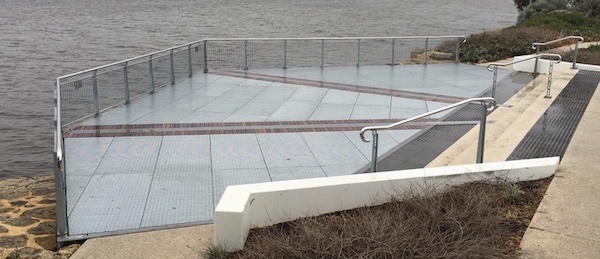
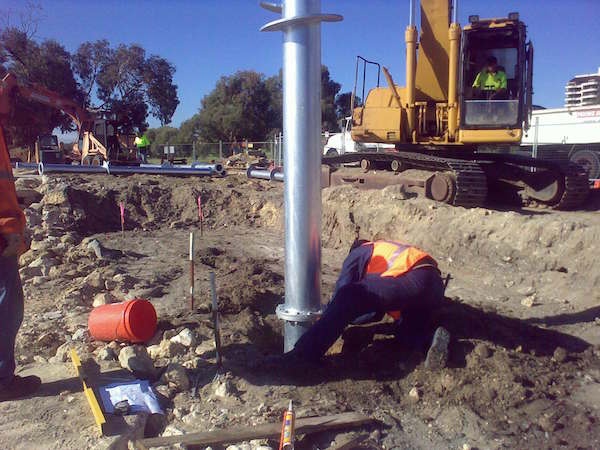
Garvey Park Swan RIver Foreshore in Ascot recently had galvanised screwpiles installed to the new boardwalk and smallcraft launching platform. Site conditions were very loose silty muds in a PASS zone extending to 4.0m in depth. Overdesign on the steel section was significant to allow for potential change to the PASS conditions. Installation has only just been completed in 2016.
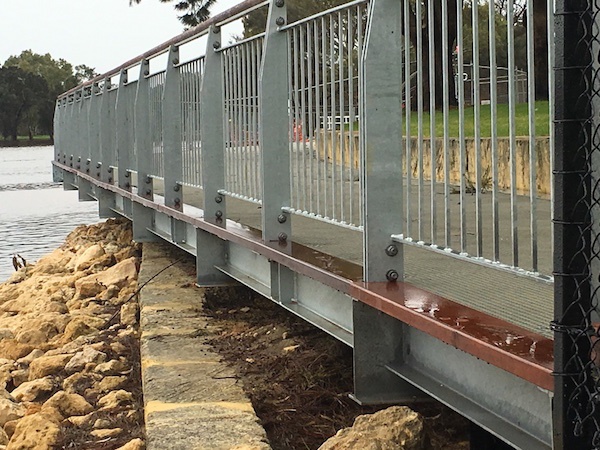
The Maylands Swan RIver walking trail span bridges had screw piles installed to new abutments. Installation of heavy walled 12m deep x 300kN compression screwpiles into PASS soil conditions occured in 2008.
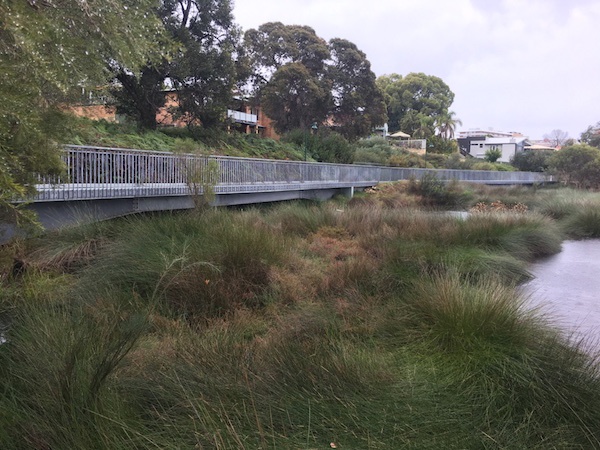
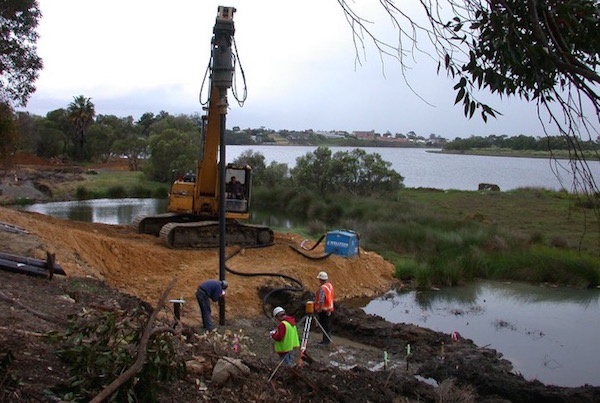
Site Summary: No additional investigation information is available for this site.
Overall Section Summary: There was no viewable evidence to support the possibility that corrosion maintanence had occures at any of the sites visited and we assume it’s unlikely to happen until serious issues create awareness. An apparent “install and forget” mentality exists regardless of who owns the asset. Our recommendations for future like projects, where a structural serviceability period exceeding 10-15 years is required the designing engineer must include additional corrosion protection measures such as Polypipe encasement, Denso petrolatum wrap or hi-build epoxy protective coating over and above standard hot dip galvanising. For the exposed pier element of the screw pile it should extend for no less than 1.5m below low water mark or land level, (i.e. where oxygen is likely to be present). Corrosion protection specification should extend to the connecting interface and where on site fabrication or modification work is conducted those works are to comply with the same specifications.
Cost Effective Solutions
Factors such as prevailing winds, ambient air and water temperature and event frequency ultimately dictate corrosion severity conditions. Where utility buildings exist the risk of voltage leakage may require electrical cathodic protection systems. AS2159’s Table 6.5.3 call’s for a steel pile sectional loss allowance of between 0.04mm and 0.1mm in severe and 0.1mm to 3.0mm per year for very severe. This indicates the degree of sectional loss can vary significantly and go way beyond what the designer had originally intended, therefore a conservative approach should be adopted. Detailed site and chemical analysis may provide additional information however the cost of the analysis often outweighs the potential cost savings on structures like these, particularly when adding the benefits of a quality corrosion protection regime in the first instance.
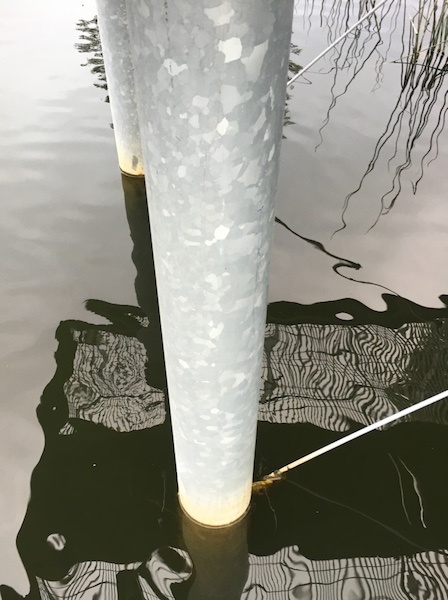
Our view is that unless a specialist corrosion paint manufacturer recommends otherwise, all screwpiles regardless of the outer protection system should be hot dipped galvanised. This will ensure any part of the protected screwpile that becomes chipped scratched or damaged during the boardwalk construction phase will still have good underlying protection. The simplest and most cost effective corrosion protection solution is to fit polyurethane (polypipe) over a hot dipped galvanised screwpile. Where the very top of the pier element or the interface connection requires additional protection, Denso wrap, oxides or hi-build epoxy paints should be applied.

Overall Observations
Exposed screw pile elements are performing in accordance with original design requirements. Where issue of corrosion exist it is the lack of corrosion inspection and maintenance that has caused issue, not the actual corrosion protection. All steel in salt water exposed sites require periodical structural inspection, the exposed screwpile elements are no exception. Whilst it was not possible to observe the embedded component of the screwpiles it is our opinion that the bearing elements of the screw piles are still within their serviceability period and are performing as intended.
Corrosion Protection Options for Screwpiles. Practical options include:
1 Oxide and epoxy coatings including hi-builds
2 Petrolatum based tapes such as Denso wrap
3 Polypipe sheathed (exposed section of pile shaft + 1.5m embedment min.) (Petro-wrap tape seal top seam)
4 Items 1 & 2 combined
5 Items 1 & 3 combined
6 Hot dip galvanising to be standard regardless of other options selected
Existing Structures Remedial Work Options. Where corrosion is identified prior to ultimate structural failure and site conditions allow, the following remedial work options may be appropriate:
1 Remove existing corrosion/scale and apply an anti-corrosion treatment such as primers, oxides, cold galvanic or hi-build epoxy coatings or similar
2 Apply Denso wrap tar tape
Where inspection identifies severe corrosion and structural compromise the following may be appropriate:
1 Cut and remove the compromised steel section and prep-clean
2 Fit new steel sleeves and or reinforced concrete encasement
3 Apply an anti-corrosion treatment such as oxides, cold galvanic or hi-build epoxy coatings or similar
4 Apply Denso wrap tar tape
Additional Consideration for PASS and ASS Soil Conditions
A detailed site chemical analysis should be carried out prior to final pile design. Screwpile installation does not generate spoils and no additional oxygen is introduced so they are likely to be suitable for these sites.
The following is the Australian Piling Code AS2159-2009, Section 6 extract, concerning steel exposure classification in water and associated sections within 6:

NOTES TO TABLES 6.5.2(A)
1) Where high levels of sulfates exist (>1000 ppm), sulfate-reducing bacteria may be present and active, sometimes leading to microbiologically induced corrosion. In such cases, classify as ‘mild’ for low permeability soils and ‘moderate’ for high permeability soils.
2) Contamination by the tipping of mineral and domestic waste or by spillage from mining, processing or manufacturing industries presents special durability risks due to the presence of certain aggressive acids (both organic and inorganic), salts and solvents, which can chemically attack steel. In the absence of site-specific chemical information, the exposure condition should be assessed as ‘severe’ for domestic refuse tips and ‘very severe’ for industrial/mining waste tips. Chemical and microbiological analysis of the latter may, however, lead to lower risk classification.
6.5.3 CORROSION ALLOWANCE FOR STEEL PILES
Where no protective coating or cathodic protection is applied, allowance shall be made for loss of section during the design life. Where a pile coating is provided, consideration shall be given to the likely life of the coating and allowance made for loss of pile section thereafter, if appropriate. Where no protection systems are to be applied to steel piles, allowance shall be made for uniform corrosion and loss of section. In the absence of other information, corrosion allowance shall be as tabulated in Table 6.5.3. In areas where site-specific corrosion rates are known, those site-specific rates may be used. Corrosion on the internal faces of a fully sealed closed-form pile may be assumed to be negligible. Where piles are electrically connected to a dissimilar metal, the resultant beneficial or adverse galvanic effect shall be taken into consideration.
NOTES:
1) Localized pitting corrosion is commonly experienced on submerged steel piles subjected to accelerated low water corrosion. Localised corrosion may also be found in the pile embedded zone close to the soil-water or soil-air interface where microbial activity is high and where scouring can maintain high corrosion activity. Such localised corrosion is not covered by the corrosion allowances given in Clause 6.4, which are averaged rates for situations where generalised corrosion occurs.
2) A cathodic protection system for steel piles is only fully effective up to approximately midtidelevel in sea or tidal waters and up to ground level in soils above the groundwater table.

NOTES:
1) The allowances in Table 6.5.3 may be reduced, as appropriate, where adequate corrosion protection systems (coatings or cathodic protection) are to be used. Coatings will reduce corrosion allowance while they remain in good condition. Coating damage, deterioration and breakdown will result in the corrosion rate increasing and, in such circumstances, the corrosion allowances in Table 6.5.3 shall apply.
2) To allow the implementation of cathodic protection after construction it is good practice to provide electrical continuity throughout the piled system at the time of construction. In providing electrical continuity, consideration shall be given to the likelihood of stray current corrosion, especially if the completed structure is of significant length and adjacent to a cathodically protected system or within close proximity to direct current electrified traction or power supply systems.
3) For very severe conditions a site-specific assessment should be sought.
6.5.4 COATING PROTECTION SYSTEMS
Consideration shall be given to the type of coating, method of application, thickness of coating, surface preparation, expected life under service conditions and the possibility of damage to the coating during installation. If it is considered that the life of the coating will be less than the required design life for the pile, appropriate allowance shall be made forcorrosion. Where a coating is to be applied to steel piles above ground level and above the low watermark, it shall be a coating that is appropriate for the environment and materials used.
NOTES:
Coating systems should comply with the requirements of AS/NZS 23122. The following coating systems for submerged and below ground steel piles are in order of increasing ‘time to first maintenance’:
(a) Epoxy mastic
(b) High-build high-solids epoxy
(c) Corrosion-inhibiting fabrics (e.g. petrolatum-tape)
(d) Polyethylene
Foundation Engineering can design and certify any future structures.
Share on Twitter Share on Facebook
Comments
There are currently no comments
New Comment